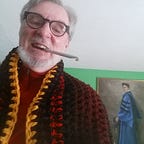The mystery of blood and pain by which Nature transforms one into two.
https://www.vnews.com/Column-The-mystery-by-which-one-becomes-two-24769345
Paul Keane
The Valley News
I’ve been apprenticing at cow births, via the television series “The Incredible Dr. Pol.” This 75-year-old totally bald Michigan veterinarian, Jan Pol, who still retains his Dutch accent, is in the 13th season of his award winning show on National Geographic TV’s “Wild” channel.
I got hooked on his bloody birthing episodes after trying to binge-watch all 63-HBO episodes of “The Sopranos” from beginning to end . I got sick of underworld blood and gore after only 28 episodes.
Tony Soprano’s gunshot murder of Big Pussy Bonpensiero gave me a nightmare when they threw his body in the ocean in a body bag loaded with cinder blocks. I woke thinking I was drowning.
So I switched to barnyard blood and gore.
I am now in my 32nd day of abstinence from violent deaths in “The Sopranos” by participating in a program of violent births in “Dr. Pol.”
And if you don’t think a cow birth or horse birth is violent, just watch Dr. Pol or one of his two assistants, Dr. Emily or Dr. Brenda, try to dislodge a calf or colt who emerges headfirst instead of head and feet first.
Chains get wrapped around the stuck feet of the smothering calf who hasn’t taken a breath yet and it is forcibly pulled from its mother by those chains, landing with a thud, placenta and all, on the ground.
If filled with fluids, the un-breathing infant is picked up by the back legs by the doctor and owner and swayed back and forth like a child’s swing, to get fluid out of its lungs and oxygen in.
The Dr. Pol show opens with a view of his humble veterinary clinic in Michigan and its sign: “Large and Small Animals”. The truth is Dr. Pol will try to fix any ailing animal, from hedgehog, parakeet, salamander, goat, horse or cow and of course dogs and cats, kittens and pups, to what seems to be his specialty, pregnant cows.
I have watched more cow births in 32 days than I have previously in my entire life, which was zero. Dr. Pol is almost joyful about pregnancy with farmers who want to be assured their cow’s fetus is still living . He puts his 2-foot plastic glove on up to the shoulder, and sticks his hand right in: “Pregnant ! Six months”, he declares.
On the way out of the barn he takes the glove off and says with his Dutch accent, to the farmer who is hoping for a healthy outcome, “Calf shook my hand. Said ‘How are ya?’ ”
Dr. Pol is philosophical about death. I have seen him put a cow down after it delivers a dead calf and is so injured by the delivery it too cannot be saved .
The farmers Dr. Pol deals with are philosophical too. One farmer looked to be in his eighties and had just lost a calf and its mother. “Things happen on a farm. You just have to accept it and move on, ” he said.
Things happen. That’s a euphemism for death.
I guess that’s the difference between violence in the “The Sopranos” and in “The Incredible Dr. Pol”: One is about people who force things to happen violently, and the other is about Nature which tries to make things happen biologically, and sometimes fails in a violent way.
I come away from Dr. Pol in awe at the mystery of blood and pain by which Nature makes one into two.
Perhaps after I fill myself with enough barnyard birthings, I may be able to finish “The Sopranos” series, but not all at once. That was my mistake. I didn’t realize “The Sopranos” is addictive.
My own veterinarian in the Upper Valley is also a small and large animal caregiver, Dr. Christine Pinello in Norwich, Vermont.
She has treated everything from an alligator to my own parade of successive dogs: 2 Dalmatians, a mongrel, a basset hound and now a yellow Lab. My cat was a six week-old kitten she rescued motherless from under a porch ten years ago.
She also makes regular farm calls every week for cows and horses and assorted farm animals. She doesn’t have a TV so she didn’t know the Dr. Pol show.
I asked her, “How do you deal with the blood and gore and sadness ?”
She knows I am a retired English teacher and here’s how she answered, using my teacher-name :
“You know, Mr. Keane, someone analyzed Shakespeare’s plays and discovered there is sadness in 47 percent of them and joy in and 53 percent of them. We view life as working toward the 53 percent.”
That’s a philosophy worthy of a National Geo TV show, don’t you think?
